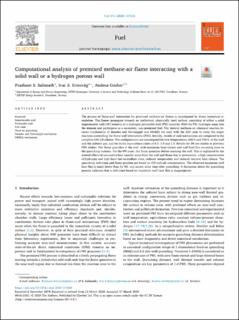| dc.description.abstract | The process of flame-wall interaction for premixed methane-air flames is investigated by direct numerical simulation. The flames propagate towards an isothermal, chemically inert surface, consisting of either a solid impermeable wall (IW) material or a hydrogen-permeable wall (PW) material. With the PW, hydrogen seeps into the domain and participate as a secondary, non-premixed fuel. The skeletal methane-air chemical reaction kinetics mechanisms of Smooke and Giovangigli and DRM22 are used with the S3D code to study the major reactions controlling the flame-wall interactions (FWI). Initially, results of said mechanisms are compared to the complete GRI 3.0 scheme. The configurations are investigated for two temperatures, 600 K and 750 K, of the wall and the unburnt gas, and for initial equivalence ratios of 0.5, 1.0 and 1.5. Results for IW are similar to previous FWI studies. The flame quenches at the wall, with maximum heat release and wall heat flux occurring close to the quenching instance. For the PW cases, the flame quenches before reaching the wall. This is explained by the mutual effects of convective heat transfer away from the wall and flame due to permeation, a high concentration of hydrogen and high local fuel-to-oxidizer ratio, reduced temperature and reduced reaction heat release. The quenching definition and flame position are based on OH radicals concentration. The observed maximum wall heat flux is much lower than for IW, and occurs some time after quenching. A discussion about the quenching process indicates that a definition based on maximum wall heat flux is inappropriate. | en_US |

